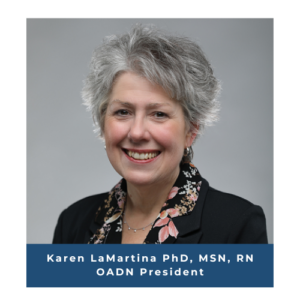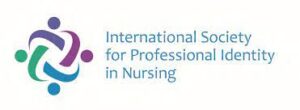By Karen LaMartina, President of OADN

Transition to nursing practice has been a source of much discussion. Recent research has suggested that most new graduate nurses struggle with making clinical judgments yielding optimal patient outcomes, leaving nurse educators to ponder, “How do we best prepare students to be practice-ready?”
NCLEX 2023: the Call for New Approaches to Instruction
The 2023 launch of the Next Generation NCLEX (NGN) necessitated a call for a change in teaching strategies, such as a flipped classroom and case studies. Nursing educators have embraced these new approaches to instruction, realizing the days of being a “sage on the stage” and reading a PowerPoint slide deck are long gone. The NGN measures the culmination of education that should strongly indicate a safe transition to practice. It will, however, be a few years before we know the significance of the NGN in the transition to practice. Will we learn that the assessment itself mattered, or were the changes made in nursing education the ones that contributed the most to a graduate’s safe and successful entry into the workforce?
The Emergence of Professional Identity in Nursing
 Professional Identity in Nursing (PIN) is a new mindset born out of grassroots “think tank” research that is now a standard of curriculum in nursing programs. Both ACEN and CNEA have added language in their standards mandating the inclusion of PIN into nursing curricula. The International Society for Professional Identity in Nursing (ISPIN) was established in 2018, following years of research identifying PIN domains. Those domains are values and ethics, knowledge, nurse as a leader, and professional comportment. Not to be confused with professionalism, which implies things such as dress code or showing up to work on time, PIN is defined as “a sense of oneself, and about others, that is influenced by characteristics, norms, and values of the nursing discipline, resulting in an individual thinking, acting, and feeling like a nurse” (Joseph & Godfrey, 2023).
Professional Identity in Nursing (PIN) is a new mindset born out of grassroots “think tank” research that is now a standard of curriculum in nursing programs. Both ACEN and CNEA have added language in their standards mandating the inclusion of PIN into nursing curricula. The International Society for Professional Identity in Nursing (ISPIN) was established in 2018, following years of research identifying PIN domains. Those domains are values and ethics, knowledge, nurse as a leader, and professional comportment. Not to be confused with professionalism, which implies things such as dress code or showing up to work on time, PIN is defined as “a sense of oneself, and about others, that is influenced by characteristics, norms, and values of the nursing discipline, resulting in an individual thinking, acting, and feeling like a nurse” (Joseph & Godfrey, 2023).
Integrating PIN into Nursing Curricula
A stepwise approach in nursing education to integrate PIN should begin on day one. Just as in practice settings, as discharge planning begins on day one of admission, the same holds for developing nursing professional identity in our students. Day one of a nursing program could include an introduction to PIN, with those domains continually reintroduced throughout the four semesters, culminating in a professional nurse who will graduate and join the workforce with a keen sense of what professional identity means.
PIN and the Clinical Judgment Measurement Model: A Synergistic Approach
All four PIN domains can be linked to the Clinical Judgment Measurement Model (CJMM). For example, when a nurse is confronted with a clinical decision, they must consider the values and ethics associated with it, draw on their knowledge, recognize themselves as the leader in the patient’s care, and then demonstrate the comportment dictated by the situation. To understand the link to CJMM, knowledge allows the nurse to recognize and analyze cues, prioritize hypotheses, and generate solutions, while one’s values, ethics, leadership, and comportment drive the nurse to take action. Professional Identity is the compass that guides practice and is a mindset that is paramount to a nurse’s ability to develop creative solutions for their patients. This should then beg the question of every nurse in practice, “Are you wearing your PIN?”
Conclusion
Nurse educators have always wondered what teaching strategies are the most effective. Is it in the classroom setting or clinical setting where students learn best? In my 30 years of experience, I have found that the most successful individuals in the nursing program are those who not only possess the ability to handle the rigorous curriculum but also have a strong sense of purpose and are willing to embrace the responsibilities of the role. Perseverance is key, but having a clear understanding of why you chose nursing is just as important, if not more so. The combination of CJMM and PIN can provide a practical marriage of clinical judgment and identity, ultimately creating a workforce of nurses who possess both the knowledge to think critically and the professional identity to carry out their work.
Joseph, M. L. & Godfrey, N. (2023). A new mindset: From tasks to professional identity.
Nurse Leader, 21(2), 183–187.
